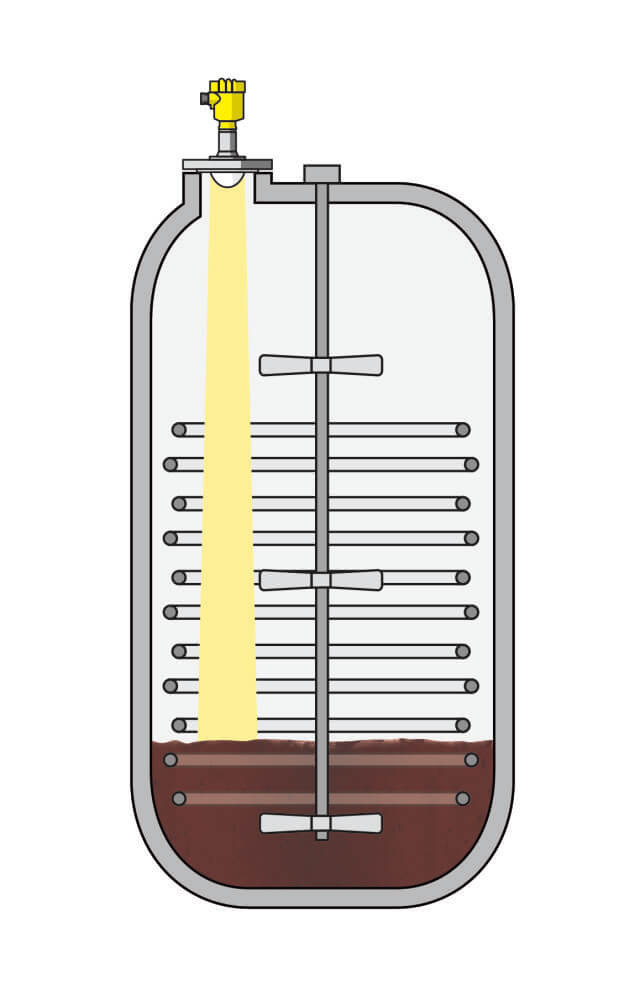Understanding the benefits of 80 GHz radar and its importance for all liquid level measurement applications
With the recent launch of radar instruments in the 80 GHz frequency range for liquid level measurement, now is a good time to examine what’s behind this new direction in radar technology. So where does it come into its own and what are the benefits of using these new sensors in automated processes for control and inventory? This development signals a brave new world in level measurement, one where radar level measurement can go where it has never gone before. With high-frequency radar level devices on the rise, this is truly an exciting era in automation.
Technology advances create availability
The readiness to use radar level sensors is a function of cost and innovation. Decreased expense has led to increased use of the technology across multiple industries. Microwave radar is a popular format for level measurement, being solid state with no mechanical parts to drift or wear and, more importantly, its immunity to pressure, vapours, temperature, viscosity and density change. Just as computer hardware prices dipped low enough to put a ‘PC in every home’ and a ‘smartphone in every hand’, it is now possible to put the latest 80 GHz radar in virtually any vessel and every plant.
Latest innovations have resulted in a technology that can be both affordable and relevant to even more general process applications. This latest generation of modern radar instruments are engineered out of decades of experience, culminating in the best ever optimised antenna designs, with larger dynamic ranges and software algorithms to filter out interference to perform even better. Now that 80 GHz radar is available and highly applicable to almost any liquid level measurement, users should get to know and accustomed to the advantages these new contactless sensors provide. The main benefits are produced through better focusing, versatile sizes, enhanced resolution, the consequently easier set up and most importantly – high performance reliability.
So what, in detail, are the main areas of development for 80GHz radar level sensors?
Focusing This is the primary advantage of 80 GHz radar – the one that makes virtually all the other benefits possible. In every contactless liquid measurement, signal focus is crucial to accurate level measurement, and these new instruments emit the most highly focused signals on the market. Plant operators have struggled with less focused radar – and ultrasonic – sensors for decades. The wider beam angle of 26 GHz sensors (and still wider 6 to 10 GHz sensors before them) made it difficult for the emitted signals to miss agitators, baffles, ladders, heating coils and other vessel internal structures. The reflections from these installations distort and confuse the echo picture to the sensor, forcing users to make (often many) adjustments to follow the true liquid level. These new high-transmission models have narrower beams that completely miss vessel installations, as if they aren’t even there. That is welcome news in pharma, chemical and food production, where obtrusive internals are often the norm and space is at a premium. Mounting nearer to vessel sides and taller nozzles, without accuracy loss, is another area of advantage – enabling use of more existing connections, especially in taller vessels. They can also be easily installed to look through process isolation valves; an application area highly desirable in the Oil and Gas processing and storage industries, for example. In summary, the superior focus makes for accurate measurement, minimal adjustment, simpler installation and maximum signal return from the product surface.
Figure 1 Focus: Using the same antenna size, this illustrates the radar beam width of 26 GHz as a grey signal path, and the narrower 80 GHz the yellow path. The sharper focusing demonstrates how it stays on the true liquid level, ignoring distracting false signals from nozzles, valves, internal structures or build on the vessel walls
Size Because their focus is so improved, 80 GHz sensors have smaller antennas. They feature the world’s smallest level radar antenna – smaller than the size of a £1 or €1 coin – so it doesn’t require a large horn to focus its beam at the product surface. A compact instrument design and small size also makes a huge impact when it comes to retrofitting. Plants can now integrate the most advanced radar devices into their process without shelling out thousands for vessel modifications. Smaller size and range instruments aren’t just good for old vessels, they can also help manufacturers stay nimble and market-responsive. There are more trends in the food, pharmaceutical and chemical industries toward batch production. Batching allows operators to produce profitable, special or seasonal versions and low-volume products, with lower financial investment. Small batches are produced in small vessels, but conventional wisdom says using contactless radar is not possible – due to the small process






